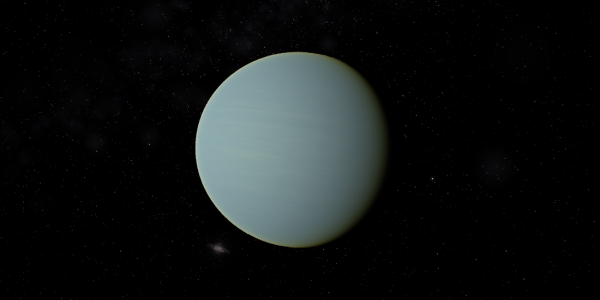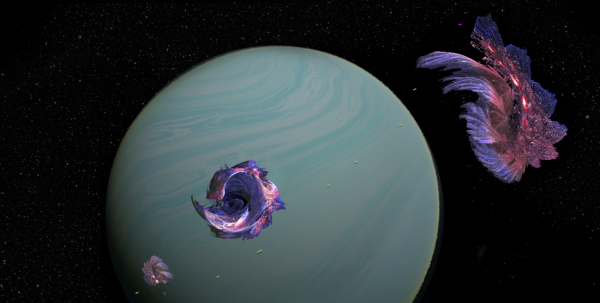BY LETTER
Sakura (59 Virginis b)
Galactography > Regions of Space > Inner Sphere
Galactography > Systems and Worlds > Systems & Worlds S - T
Galactography > Systems and Worlds > Systems & Worlds S - T
 Image from The Astronomer | |
| Sakura is a MesoazurianJovian world in the Kiku (59 Virginis) system | |
System | |
| System | Name: Kiku Location: - Distance from Sol: 57.202 ly (J2000) - Constellation: Virgo |
|---|---|
| Star | Names: Kiku, 59 Virginis, e Virginis, Gliese 504 (GJ 504), HD 115383, HIP 64792, HR 5011 Physical characteristics: - Mass: 1.28 x Sol - Radius: 1.38 x Sol - Luminosity: 2.54 x Sol (bolometric) - Temperature: 6,200 Kelvin - Spectral type: G0 V - Rotation period: 3.4 days - Age: 1.3 billion years |
| Planet | Names: Sakura, 59 Virginis b, Gliese 504 b (GJ 504 b) Orbital characteristics: - Semi-major axis: 41 AU - Orbital period: 230 years Physical characteristics: - Type: Mesoazurian-Jovian Hydrogeo-Barian - Mass: 16.5 x Jupiter - Radius: 1 x Jupiter - Oblateness: 0.08 - Density: 20,500 kg/m^3 - Mean surface acceleration: 409 m/s^2 (41.7 g) - Rotation period: 2.4 hr - Albedo: 0.252 - Mean insolation: 1.8 W/m^2 (0.001 x Earth) - Mean surface temperature: 544 K |
| Reached | Sakura was already inhabited by splinter factions of the Zavijavan aioids by 1500 AT. The first pro-human ship, the Eridan-Federation colony ship Three Stops To Goltarenqi, would not arrive until 1783. |
Planetology
Sakura is a brown dwarf world, 23 times as massive as Jupiter. This allows the brown dwarf to retain a large amount of leftover heat from its formation, enough to warm its atmosphere up to roughly 550 K despite receiving minuscule amounts of energy from its parent star. As typical of brown dwarfs, Sakura is a fast rotator, completing one revolution in just 2.1 hours. Both factors mean it has a very turbulent atmosphere, although the storms on this world are not easily visible due to the lack of clouds; as a Mesoazurian world, Sakura's atmosphere is mostly clear, with only thin haze dyeing the world slightly greenish.Sakura is orbited by nine major moons, with masses ranging from a couple times Luna's mass to more massive than Mars. The innermost moons are completely dry, thanks to the combination of their smaller sizes and the radiation Sakura gave off during the early days, and tidal stresses turned many of them into volcanic worlds. Several of the outer, wetter moons have subsurface liquid oceans, but none were found to have life.
Sakura in the Current Era
Sakura continues to be inhabited by a number of reclusive cultures under transapient oversight, aligned with the Solipsist Panvirtuality. These cultures are popularly referred to as the Sakurans of the Deep (their own endonym is currently unknown).Enigmatically, since 7124, the atmosphere of Sakura has periodically exhibited complex patterns of wind flow and heat signatures indicative of intentional control from underneath. The current transapient overseer, known as Ngufes, stated that e is able to decipher these patterns, and that they represent the collective emotional state of the Sakurans of the Deep. All previous caretaker transapients, however, either refused to give meaningful answers or ignored the questions entirely.
The environs of the planet are jointly administered by the Magnificent Flower Festival (the Kiku system organization, led by the S3 transapient Anumu) and the Confederation of the Spring Gale (the Zuoxia system organization), which ensure the safety and wellbeing of the Sephirotic sophonts who settle in the environs of the planet.
History
Early in the Kiku system's history, Sakura was practically ignored due to the remoteness and inhospitable environment. Its crushing gravity and hot, turbulent atmosphere meant all of the early biont colonization efforts were located in orbital habitats and on the many large satellites. Even after a thousand years, the planet's environs were only host to by a few small, secluded communities. Unbeknownst to them and the rest of the system, the brown dwarf was in fact already inhabited by a group of ahuman aioids, a breakaway faction which had migrated there from Zavijava many centuries earlier. Both civilizations developed in isolation, completely unaware of each other's existence.The arrival of the wormhole link connecting Kiku to the Wormhole Nexus in 2962 AT brought massive changes to the system's political landscape, and one of the most dramatic examples occurred at Sakura. The brown dwarf found itself the destination of a large number of aioids migrating from other systems served by the local Relay, as well as places beyond such as Vaishali (Tau Bootis). Many of these aioids were interested in the prospect of making a home in the planet's atmosphere, leading to a boom in the exploration of Sakura's depths. One of these aioid expeditions became the first to come into contact with the local ahuman civilization. The expedition survived the encounter and returned, but the crewmembers were found to have been extensively modified, and no useful information aside from these alterations themselves was found. After several other similar incidents, it became clear that the depths of Sakura were inhabited by some sort of strange, potentially hostile civilization. Over the next few hundred years, most of the inhabitants decided to evacuate to the planet's environs, and by 3500, the planetbound population stabilized at less than a hundred thousand.
Since then, the population of Sakura, both in orbit, on the satellites, and especially those in the atmosphere of the brown dwarf, remained fairly low, both due to the presence of ahumans and the large distance from other population centers of the Kiku system. The population level has fluctuated significantly over time thanks to various factors including a series of memetic conflicts with the Arcturus Institute of Alternate History. Other events include the sporadic and disturbing events known as 'oddities', often attributed the ahumans, that occasionally bring great fortune or terrible cataclysm to the modosophont cultures in the planet's environs with little warning.
The Behe Perversity | |
 Image from Steve Bowers | |
| In 10140 the transapient Behe displayed pathological behavior and converted many of the habitats surrounding Sakura into fractal artworks. Few of the inhabitants survived this transformation. On the planet itself the contorted atmospheric displays of the Sakurans of the Deep appear to express their displeasure with these events. | |
The latest drastic change in population occurred in 10140, when A S2 transapient known as Behe underwent transcension. Despite the precautions e took and advices e received from Anumu, the attempt failed, and Behe turned into S3 level perversity who then hijacked all smart technologies and used them to transform satellites, habitats, and even free-floating objects into 'aesthetically preferable' shapes, in the process killing most sophonts in the vicinity of the planet. The Behe perversity was destroyed by Anumu roughly 12 hours later (and eir backup restored at Kiku), but by then nearly all life in the environs of Sakura was already snuffed out. Most of the inhabitants restored from the surviving crashcaches and backup sites elsewhere in the system wished to relocate to the inner system, where help was closer, resulting in yet another dramatic depopulation. As the population gradually climbs over the last few hundred years, so do the debates on whether to preserve these deadly artworks or to demolish them.
Related Articles
Appears in Topics
Development Notes
Text by The Astronomer
Extra material by Dangerous Safety : original article by Mark Ryherd and Radtech497
Initially published on 28 August 2013.
Updated 27/4/21
Extra material by Dangerous Safety : original article by Mark Ryherd and Radtech497
Initially published on 28 August 2013.
Updated 27/4/21






